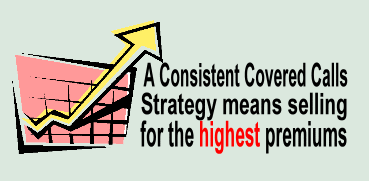A lot of investors look at covered calls as a very simple strategy. Buy shares and sell covered calls out of the money and if the stock reaches that price by the time of options expiry then be exercised, make some profit and look around for another opportunity to repeat the covered calls strategy perhaps even on the same stock. If the covered calls expire by the time of options expiry then sell another round of covered calls and wait again. Sounds good and certainly no problem with that covered calls strategy. What’s not to like. It is straight forward, simple and yes it does work, perhaps not all the time, but it certainly does some of the time if the investor is lucky.
But using a “hit and miss” covered calls strategy rather than a solid strategy is not for everyone and certainly if you have a long-term position in a stock or ETF such as AGQ ProShares it is not going to work most of the time and consistent compounding of covered calls income is what investors need to be successful in reducing their cost basis in the stock.
In my series on AGQ ProShares Dan has a position of 4500 shares which he bought at $90 and has a cost basis of $75 after selling covered calls. Dan’s goal is selling his AGQ ProShares for $500.00 and he is willing to wait it out.
Dan knows this is not going to happen overnight so Dan needs some strategies. Why would anyone buy AGQ ProShares for $90, especially 4500 shares and spend $405,000.00 and then sit back and wait for it to happen. Dan needs to keep that $405,000 earning capital. Even if he earns just 10% in a year that’s another $45,000 which if he used the Cry Baby Stock Trading Strategy (one of my personal favorites) or the Twin Sister Put Selling Strategy or even The Shark Option Trading Strategy he could reinvest it back into AGQ ProShares and earn more than 10%.
It makes a lot of sense to keep your capital working all the time. In a market crash if you didn’t get out then you want your capital working all the time to bring in more capital, build up your available cash perhaps to buy what are now undervalued shares, while you wait for a recovery in your underlying shares.
But to keep your capital working, hold onto your stock or ETF positions especially if your are underwater in your shares (below your cost basis) you need strategies that work. They must earn you capital, compound that capital AND make darn sure you don’t lose control of the shares you originally wanted in the first place, for what you perceive is going to be a terrific return when those shares run back up to your ultimate goal.
I cannot express enough the importance of having a plan. Without a plan you cannot be consistently successful in investing and it is consistency that will compound and grow your capital. Here we have a reader’s question on covered calls which it best answered in an article and not on the comments list:
Covered Calls Questions
This question today from LenPetry on Part 1 of AGQ ProShares Ultra Silver Investing Strategies. His comment is in the comment section at the bottom of that article. Here is what he asked:
From LenPetry:
9) It is important to NEVER sell covered calls when AGQ ProShares ETF or price of silver is in a pronounced decline.
This I don’t understand. If you sell a call with the strike slightly above stock price, you make a large premium. If the stock price then declines, the covered call is worth less and you can buy to close with a profit, no?
My Covered Calls Answer :
Remember The Strategy Is To Earn Highest Call Premiums. If you sell your covered calls in a pronounced decline you are not, as you indicate in your question earning “a large premium”. You are in fact earning less than you would have in a rally in the underlying shares.
Remember the paragraph that starts up the list of key aspects: “Based on the above information and my past trading knowledge I can come up with a number of key aspects that could be used to develop different trading strategies for AGQ ProShares.”
There are DIFFERENT trading strategies that could be developed around these key aspects. This is why I wrote the other two parts on the AGQ ProShares article detailing out a total of 7 different trading strategies.
Remember the Strategies:
Strategy 1 – Staying Simple
Strategy 2 – Staggered Covered Calls Strategy
Strategy 3 – The Extra Mile Strategy
Strategy 4 – The Gambler Covered Calls Strategy
Strategy 5 – The Cry Baby Stock Trading Strategy
Strategy 6 – The Twin Sister Put Selling Strategy
Strategy 7 – The Shark Option Trading Strategy
Remember that whatever you do with your covered calls strategy it has to be part of the overall plan and it has to be consistently profitable. Selling covered calls in a pronounced decline is rarely profitable. In a pronounced decline, selling covered calls is normally an effort by the investor to try to grab some premium to get some protection against the large decline. Selling covered calls on AGQ ProShares and even earning $5.00 is not much protection when it collapsed over 50% on Dan. Selling covered calls in a pronounced decline is not a strategy, it is usually fear.
Each of the above strategies has a start and end point. They can be combined to work together. For example any of the covered calls strategies can be combined with the Cry Baby Strategy, The Twin Sister Strategy and The Shark Strategy. But they have clearly defined goals, objectives and plans.
If you DO NOT have a strategy in place and you DO NOT stay consistent but get SHAKEN OUT of your strategy you will NEVER be successful. This is why a lot of investors plot out more than one strategy and often combine them and implement them depending on the stocks or ETFs they have chosen.
Why Not Sell Covered Calls On A Decline In AGQ ProShares?
So back to your question, for covered calls strategies to be successful and earn good premiums while not losing control of your underlying security, you will ALWAYS want to sell your covered calls on the advance in the ETF not a decline and not a pronounced decline. An Ultra ETF is a volatile investment. Therefore there are going to be lots of ups and downs and you want that.
Make Use Of Your Technical Timing Tools To Sell Covered Calls and Buy Them Back
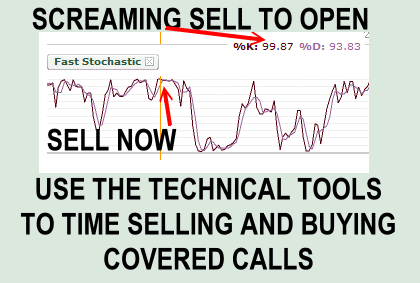
Using Technical Timing Tools To Time Entry And Exit Points For Covered Calls Is An Excellent Strategy
Wait for the underlying shares to rally and adjust for example the Shark Strategy so that you follow the Fast Stochastic indicator. When it is screaming 98% or 100% on a move higher sell your covered calls. You will earn the highest call option premium on the rise in AGQ and almost always pick the top of that rise which will limit the chance of losing your shares through your covered call or worse, buying the covered calls back for a loss and trying to roll out or roll up.
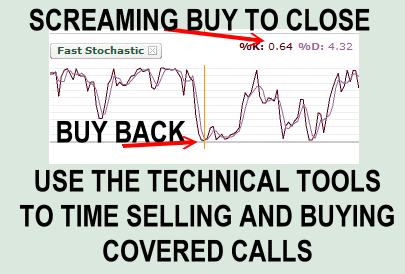
Use The Same Technical Timing Tools To Time When To Buy Back (or buy to close) Your Covered Calls and Then Get Ready To Repeat The Cycle On The Next Advance In The Underlying Security
Then wait for the fall in AGQ prices or again turn to the Fast Stochastic. When it is screaming 1%, 2% or 0% buy back those covered calls for a very tidy profit. Then you wait for the next cycle.
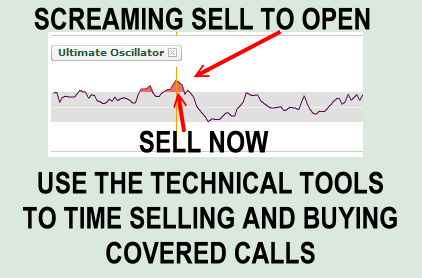
There are lots of technical timing tools to help investors successfully and consistently trade in covered calls. Think outside the box. Think about covered calls as a supplementary strategy to your underlying shares. You can buy and sell them as often as you want. AGQ ProShares being an Ultra ETF provides some of the best options premiums for a sound covered calls strategy.
Never Sell Covered Calls In A Decline
So you would NEVER want to sell covered calls on a decline. If your strategy was to earn the best covered calls premiums when you are selling your covered calls you always sell on the advance in the underlying shares.
Consider This
If you are new to using covered calls as a strategy turn to the Staggered Covered Calls Strategy and turn it into a Covered Calls Ladder. On the advance, each time the Fast Stochastic is screaming OVERBOUGHT sell another round of covered calls at higher strikes.
Nothing is written in stone for investing. No rule says you must commit all 45 Covered Calls contracts at once and pray it works out. Stagger them and leave some shares open as in The Gambler Strategy which will give you rescue options that can still protect your underlying shares AND the capital you have already earned to date through selling covered calls.
Think outside the box as it were. Think that those covered calls could be a strategy unto themselves and the underlying shares are your ticket to earning even more with your trade.
$405,000.00 is a lot of capital. If it was my capital I want my strategy to be sound and to work not just by chance but by design. (Hey a plug for my article – Put Selling By Design – anyone remember those?).
Without A Plan, Well Good Luck
Len, you must have a plan. If your plan is to sell covered calls on a decline then good luck. But if your plan is to get your capital working hard, make the best premiums, compound your earnings from covered calls, and protect the underlying shares from being exercised while waiting for your Ultimate Goal, then you must have a plan.
Make Your Capital Work Hard
Ultra ETFs like AGQ ProShares are terrific for option premiums which is why investors or in our case option sellers are drawn to them. You want to make them work hard for you and that can only happen if you wait for the rise, sell the covered calls, wait for the fall and buy them back.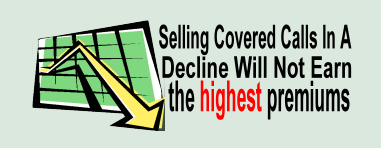
Never Sell Covered Calls In A Decline
So yes, never sell covered calls in a decline, you should have already sold them in the advance. In the decline buy them back. Think longer than a week or a month. Think long, long-term because Dan might be in this trade a lot time. Why not buy and sell your covered calls just like buying and selling stock only in reverse. That is what the Shark Option Trading Strategy is all about.
PUT THIS ON YOUR MONITOR
Put a sticky note on your computer monitor with this line: “High Stock check Fast Stochastic- sell covered calls; Low Stock check Fast Stochastic- buy back covered calls; Then GET READY for the next cycle“.
Become a Shark Trader like in The Shark Option Trade Strategy (shameless plug)
Forget Fear
Investors tend to fear what is happening to their stock. It declines they worry and think I have to protect my shares and they sell covered calls on the way down.
Forget fear and focus on your goal. If Dan’s goal is to ride this stock to brand new highs way all the way to $500.00 that is definitely going to take some time to happen. With a strategy in place you welcome the volatility and you realize when to sell your covered calls and when to buy them back to repeat the cycle.
Imagine What A Covered Calls Strategy Can Accomplish
Just imagine if by implementing some of the strategies discussed in these AGQ ProShares articles, Dan earned back more than half of his original capital through applying strategies consistently, and still had his 4500 shares.
It is more than possible as my Kraft Stock trades and many others have shown. Dan could get his cost basis through covered calls and other strategies down to less than half of what he paid and finally if AGQ ProShares runs to $500.00, well Dan is going to be an incredibly happy investor. I hope Dan keeps us advised of what happens with his covered calls and his AGQ ProShares trade.
Read AGQ ProShares Ultra Silver Investing Strategies Part 1
Read AGQ ProShares Ultra Silver Investing Strategies Part 2
Read AGQ ProShares Ultra Silver Investing Strategies Part 3
Read AGQ ProShares Covered Calls Questions


